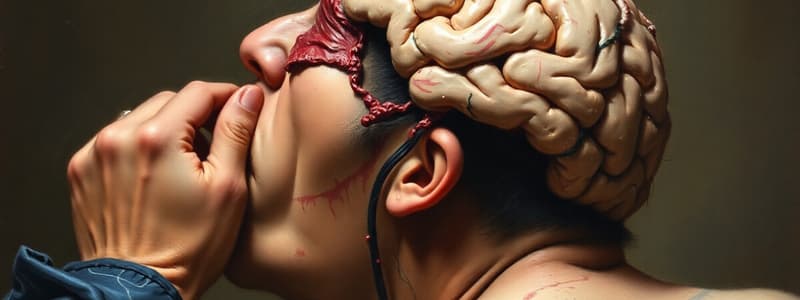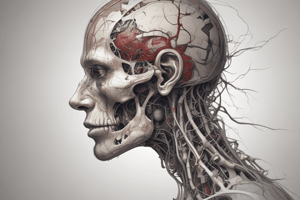Podcast
Questions and Answers
What is the significance of a serum osmolality exceeding 320 mOsm in the use of mannitol?
What is the significance of a serum osmolality exceeding 320 mOsm in the use of mannitol?
- Mannitol dosage needs to be increased
- Mannitol becomes ineffective (correct)
- Mannitol should be avoided completely
- Mannitol must be used in combination with another drug
Which of the following is NOT an early sign of increased intracranial pressure (ICP)?
Which of the following is NOT an early sign of increased intracranial pressure (ICP)?
- Disorientation
- Restlessness
- Pupil changes (correct)
- Increased respiratory effort
In managing increased ICP, which strategy is NOT typically employed?
In managing increased ICP, which strategy is NOT typically employed?
- Controlling fever
- Restricting fluids
- Administering high-dose steroids (correct)
- Draining CSF
What key condition must be excluded before declaring brain death?
What key condition must be excluded before declaring brain death?
Which procedure involves inserting a fine-bore catheter into a lateral ventricle for ICP monitoring?
Which procedure involves inserting a fine-bore catheter into a lateral ventricle for ICP monitoring?
What is the primary assessment tool used to evaluate a patient's level of consciousness?
What is the primary assessment tool used to evaluate a patient's level of consciousness?
What physiological change is primarily characterized by an increased systolic blood pressure, widening pulse pressure, and bradycardia?
What physiological change is primarily characterized by an increased systolic blood pressure, widening pulse pressure, and bradycardia?
What is the first priority in the management of a patient with altered level of consciousness due to increased ICP?
What is the first priority in the management of a patient with altered level of consciousness due to increased ICP?
How does mannitol help in managing increased ICP?
How does mannitol help in managing increased ICP?
Which of the following indicates a Cushing triad in a patient experiencing increased ICP?
Which of the following indicates a Cushing triad in a patient experiencing increased ICP?
What could be a potential side effect of administering mannitol?
What could be a potential side effect of administering mannitol?
In what scenario might a low Glasgow Coma Scale score indicate?
In what scenario might a low Glasgow Coma Scale score indicate?
Which of the following management approaches is NOT appropriate for increased ICP?
Which of the following management approaches is NOT appropriate for increased ICP?
What characterizes a patient in a coma?
What characterizes a patient in a coma?
Which of the following is a distinguishing feature of persistent vegetative state?
Which of the following is a distinguishing feature of persistent vegetative state?
Which statement correctly describes the symptoms of intracranial hemorrhage?
Which statement correctly describes the symptoms of intracranial hemorrhage?
What is the most appropriate first step in managing brain injuries?
What is the most appropriate first step in managing brain injuries?
In cases of diffuse axonal injury, what immediate response is expected?
In cases of diffuse axonal injury, what immediate response is expected?
What does the management of increased intracranial pressure (ICP) primarily rely upon?
What does the management of increased intracranial pressure (ICP) primarily rely upon?
What is the importance of the Glasgow Coma Scale in assessing brain injuries?
What is the importance of the Glasgow Coma Scale in assessing brain injuries?
Which best describes Cushing's response in brain injury patients?
Which best describes Cushing's response in brain injury patients?
Flashcards
LOC
LOC
Level of Consciousness; a measure of the patient's responsiveness and awareness
Increased ICP
Increased ICP
Elevated intracranial pressure, a critical condition decreasing cerebral blood flow and potentially causing brain herniation.
Cushing's Triad
Cushing's Triad
Bradycardia, hypertension, and bradypnea (slow breathing) - characteristic late signs of increased intracranial pressure.
Glasgow Coma Scale
Glasgow Coma Scale
Signup and view all the flashcards
Mannitol
Mannitol
Signup and view all the flashcards
Cerebral Edema
Cerebral Edema
Signup and view all the flashcards
Patent Airway
Patent Airway
Signup and view all the flashcards
Cerebral Perfusion
Cerebral Perfusion
Signup and view all the flashcards
Mannitol limitation
Mannitol limitation
Signup and view all the flashcards
Controlling ICP: Early signs
Controlling ICP: Early signs
Signup and view all the flashcards
Controlling ICP: Late signs
Controlling ICP: Late signs
Signup and view all the flashcards
Ventriculostomy purpose
Ventriculostomy purpose
Signup and view all the flashcards
Brain death criteria
Brain death criteria
Signup and view all the flashcards
Contusion
Contusion
Signup and view all the flashcards
Diffuse Axonal Injury
Diffuse Axonal Injury
Signup and view all the flashcards
Intracerebral Hemorrhage & Hematoma
Intracerebral Hemorrhage & Hematoma
Signup and view all the flashcards
Intracranial Hemorrhage
Intracranial Hemorrhage
Signup and view all the flashcards
Altered Level of Consciousness (LOC)
Altered Level of Consciousness (LOC)
Signup and view all the flashcards
Persistent Vegetative State
Persistent Vegetative State
Signup and view all the flashcards
Locked-in Syndrome
Locked-in Syndrome
Signup and view all the flashcards
Study Notes
Neuro Trauma
- Neurologic trauma can be life-threatening or life-altering.
- Neurologic trauma affects the patient, family, healthcare system, and society.
- Nurses collaborate with many healthcare team members.
Head Injuries
- Includes injuries to the scalp, skull, or brain.
- Most common cause of death from trauma in the US.
- Most common cause of TBI are falls.
- Males aged 15-24 are at highest risk.
Pathophysiology
- TBI has two forms:
- Primary injury: Initial damage from the traumatic event.
- Secondary injury: Evolves hours or days after the initial injury, often due to cerebral edema, ischemia, seizures, infection, hyperthermia, or hypoxia.
Skull Fractures
- Break in the skull, potentially with or without brain damage.
- Types:
- Simple: A break in the bone.
- Comminuted: Splintered fracture line.
- Depressed: Embedded bone fragments in brain tissue.
- Basilar: Fracture at the base of the skull (can cause CSF leakage from ears and nose).
- Fractures can be open or closed.
Clinical Manifestations
- Clinical presentation depends on the severity and distribution of injury.
- Basilar fractures may cause bleeding from the nose, pharynx, ears, or conjunctiva.
- Assessment and diagnosis include X-rays, physical & neurological exams, and MRI (when stable).
Nursing Care
- Close monitoring for changes in neurological status.
- Depressed fractures usually require surgery.
- Basilar fractures:
- Avoid nasal suction and blowing the nose (use oral NG tube).
- Maintain head of bed (HOB) at 30 degrees.
- Monitor for infection & CSF leakage from ears & nose.
- CSF from the nose for 3-5 days may not require surgery.
- CSF from ears usually does not require surgery.
Brain Injury
- Major factor: Brain injury.
- Open brain injury: Object penetrates skull and enters brain tissue.
- Closed brain injury: No opening in the skull or dura.
Types of Brain Injury
- Concussion: Alteration in mental status (lasting 24 hours or less), headaches, nausea, vomiting, photophobia, amnesia, blurry vision, difficulty speaking, and difficulty awakening. Possible seizures and weakness on one side of the body.
- Contusion: Bruising of the brain with possible surface hemorrhage, unconsciousness lasting more than seconds/minutes. Symptoms depend on severity & brain swelling. Potential for unconsciousness to return, irritability & disturbance to normal bodily functions.
- Diffuse Axonal Injury: Widespread damage to multiple brain areas. Immediate coma, cerebral edema, and posturing.
Intracranial Hemorrhage
- Hematomas developing in the cranial vault.
- Symptoms can be delayed until the hematoma is large.
- Clinical presentation depends on the affected brain areas.
- Can be due to force, bullet wounds, or stabbings.
- Supportive care, ICP control, or surgical interventions may be needed.
Altered Level of Consciousness
- Unresponsive patients may need persistent stimuli to achieve alertness.
- Coma: Unarousable, unresponsiveness
- Persistent vegetative state: Patient resumes sleep-wake cycles but has no cognitive or affective function.
- Locked-in syndrome: Damage to the pons or midbrain, resulting in quadriplegia, inability to speak, but vertical eye movements remain intact (important indicator of consciousness).
Intracranial Pressure (ICP)
- Increased ICP reduces cerebral perfusion, causes ischemia, shifts brain tissue, and can lead to herniation.
- Early signs of increased ICP include disorientation, restlessness, and increased respiratory effort.
- Late signs: pupil changes, impaired extraocular movements.
- Cushing response: Increased systolic BP, widening pulse pressure, and slowed heart rate (grave sign) indicative of significant blood flow decrease.
- Significant decline in brain status and vital signs, herniation & occlusion of blood flow can occur.
Glasgow Coma Scale (GCS)
- Tool for assessing level of consciousness.
- Components include eye opening, verbal response, and motor response.
- Scores range from 3 to 15, with lower scores indicating a more serious condition.
Management of Increased ICP
- Decrease cerebral edema.
- Lower CSF volume.
- Decrease cerebral blood flow while maintaining perfusion.
Studying That Suits You
Use AI to generate personalized quizzes and flashcards to suit your learning preferences.




